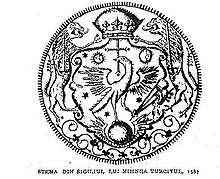Mihnea Turcitul
| Mihnea II Turcitul | |
|---|---|
| Prince of Wallachia | |
 | |
| Reign | 1577–1583 |
| Born | 1559 |
| Died | 1601 |
| Wives |
|
| Issue | Radu Mihnea |
| House | Drăculești |
| Father | Alexandru II Mircea |
| Mother | Catherine Salvaresso |
| Religion | Islam |

Mihnea II Turcitul ("Mihnea the Turned-Turk"; 1564–1601) was Prince (Voivode) of Walachia between September 1577 and July 1583, and again from April 1585 to May 1591.
The only son of Alexandru II Mircea and Ecaterina Salvaresso, he ascended to the throne after events characteristic for the decline in prestige of local custom and princely power under pressure from the Ottoman Empire (Wallachia's suzerain): Mihnea had to compete with a foreign pretender, the Lombard physician Rosso, who claimed to be descended from a Wallachian ruler,[1] and ultimately succeeded after enlisting the help of his grandmother, the influential Lady Chiajna.[2]
He, Ecaterina Salvaresso, and Chiajna subsequently established what would become a highly unpopular rule, which followed the political guidelines imposed by Alexandru II, and saw a major increase in taxes — around 1583, the pressure was leading peasants to abandon their plots and flee to Transylvania in large numbers.[3]
Local boyars unsuccessfully petitioned the Porte citing Mihnea's youth, began talks with a certain Pătrașcu or Radul Popa (who claimed to be the son of Pătrașcu cel Bun), and eventually rebelled in Oltenia (under the leadership of the Craiovești family).[4] A more powerful pretender was the real son of Pătrașcu cel Bun, Petru Cercel, who held the throne from 1583 to 1585, provoking Mihnea's exile to Tripoli (where he was kept in custody by Ottoman authorities).[5]
His wealthy mother's family gave gifts to the officials of the sultan in order to purchase back the throne. The obligations he contracted in order to have Petru removed (around 700,000 scudi) forced Mihnea to increase the fiscal burden, and especially the quit-rent, to even higher levels upon his return to Bucharest.[6] In addition, Mihnea allegedly promised Grand Vizier Koca Sinan Pasha as many gold coins as 600 horses could carry, in order to have Petru killed;[7] in March 1590, his request was granted by Sultan Murad III, who ordered Petru's execution in exchange for 70,000 gold coins.[7]
One year after his mother Catherine's death, the Turks removed Mihnea for the second time. Despite the established contacts, the Ottomans deposed Mihnea in favor of Ștefan Surdul (who was allegedly a leather cutter and harness maker by trade).[8] After moving to Anatolia, he bade without success for the throne in Moldavia.[8]
In a desperate attempt to regain the throne, Mihnea and his eldest son converted to Islam. This is why he is known as "Turcitul" or "the Islamized". The move qualified him for Ottoman administrative office - he was awarded the sanjak of Nikopolis (in today's Bulgaria) under the name of Mehmed (or Mehmet) Bey.[9] These un-traditional gestures did not prevent his youngest son, Radu Mihnea, from becoming Prince in 1601.
He died in Istanbul in 1601 and was buried in an unmarked grave.
| Preceded by Alexandru II Mircea |
Prince of Wallachia 1577–1583 |
Succeeded by Petru Cercel |
| Preceded by Petru Cercel |
Prince of Wallachia 1585–1591 |
Succeeded by Ștefan Surdul |
Notes
References
- (Romanian) Letopisețul Cantacuzinesc
- Ștefan Ștefănescu, Istoria medie a României, Bucharest, Vol. I, 1991
- A. D. Xenopol, Istoria romînilor din Dacia Traiană, Vol. V, cap. 3, Iași, 1896